Rarely ships have been given the privilege of a very long career as a flagship of an entire navy, nor having such historical significance. RHN Giorgos Averof was probably the best example which can be found in naval history. Ordered in 1908 as a modified Italian Pisa-class armored cruiser, and financed, not by the state, but by a private individual (which gave the ship his name in return), Giorgos Averof became instantly the flagship of the Hellenic Navy. She fought during the Balkan war in 1912, WW1, WW2 and was still in service in 1952, seeing the early cold war. Decommissioned from the Navy, she resumed her service, this time as a museum ship. Still around today, she can be visited in Thessaloniki.
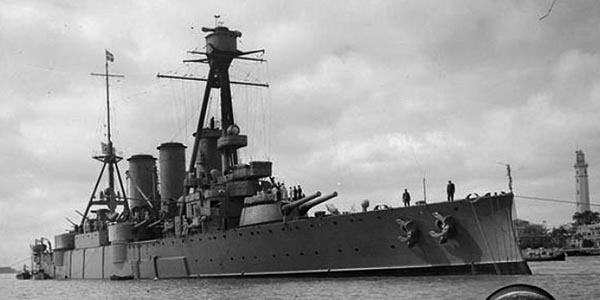
Long service: Averof at Port Said, as guardship 23 February 1943. Next, she was sent in India.
Genesis of the Giorgios Averof
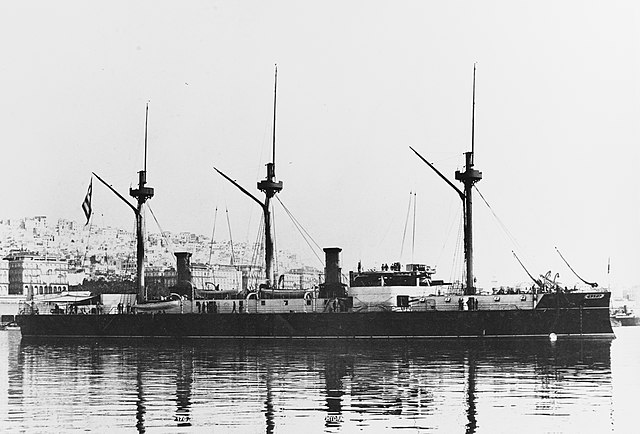
Ironclad hydra
Situation of the Hellenic Fleet in 1905
In 1905, Greece has a motley collection of more or less obsolete ships. Its most important were the three armoured ships class Hydra (1889). The Hydra, Spetsai, and Psara were ordered in France in 1885, and typical of the early jeune ecole concepts. On a 4800 tonnes displacement, they carried three 10.8-inch (274 mm) Canet guns and five 5.9-inch (150 mm) Canet guns, while being protected up to 305 mm and still able to reach 17 knots.
They were mostly inactive during the Greco–Turkish War in 1897, due to the Ottoman ships staying in harbour most of the time. The experience nevertheless led to think after a faster ship. The three Hydra-class were later modernized in 1908–1910, whereas the Greek authorities launched a large rearmament program in 1905-07, first procuring eight destroyers and later were about to submit a tender for an armoured cruiser.
An opportunity: The Pisa-class cruisers
However events unfolded quickly. In 1905, three Pisa-like armoured cruisers were in construction in Italy. However, Orlando Shipyards in Livorno was building a third ship in 1907 When the Italian government cancelled her due to budgetary concerns. Informed by a naval attaché, the Greek government immediately stepped in, and purchased her with her limited budget, representing one-third (ca. 300,000 gold pound sterling) of the total purchase, as a wealthy Greek benefactor, Georgios Averof, paid the remainder.
The man, Giorgios Averof:
Greeks seems through history to have been innate traders, generating famous billionaires. The most prominent was Basil Zaharoff, probably the most (in)famous arms dealer of all times, and later Panayis Vaglianos in the 1950s and rival Stavros Niarchos, Aristotle Onassis in the 1960s. George M. Averoff (1815-1899) was a businessman and philantropist born in Epirus, which made his fortune in Egypt before moving into the business of banking, real estate and then purchased most of the shipping on the Nile. He started donating to charity, opening schools throughout Egypt, and later in Greece, helping the Panathenian Stadium restoration for the 1896 Summer Olympics, and after he passed out in 1899 in Alexandria, he donated part of his wealth to the government in his testament, with a bequest of 300,000 GBP. The government made him a Major National Benefactor and two statues were erected.
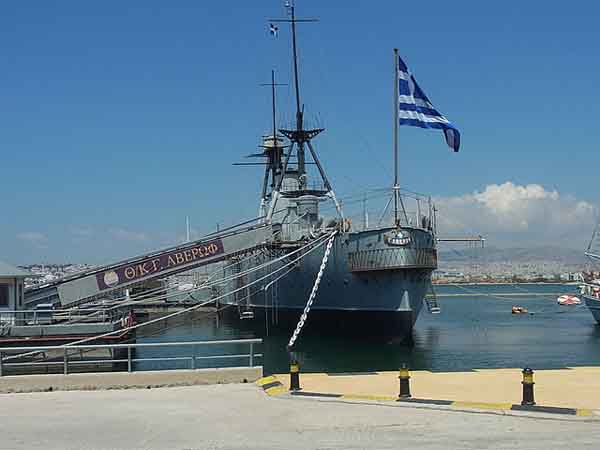
Giorgios Averof in 2013
Design & construction in Italy
The Pisa class first design dated back from 1904. At the time, it was due to Italian engineer Giuseppe Orlando, which was basically trying to create a reduced version of the Regina Elena-class battleships. Only the first two, Pisa and Amalfi, entered service. They were denominated “large armored cruisers” or second-class battleships. They were on the top opf their game as cruisers, but yet too small to be considered as battlecruisers, which appeared as they were completed.
These armoured cruisers measured perpendiculars 130 meters (426 ft 6 in), 140.5 meters (460 ft 11 in) overall, with a 21 meters (68 ft 11 in) beam and 7.1 meters (23 ft 4 in) draft. They displaced 9,832 metric tons (9,677 long tons) standard, up to 10,600 metric tons and 10,433 long tons deeply loaded. Complement comprised 32 officers and 652-655 enlisted sailors. Giorgios Averof was laid down at Orlando, Livorno in 1907, launched on 12 March 1910 and completed on 16 May 1911.
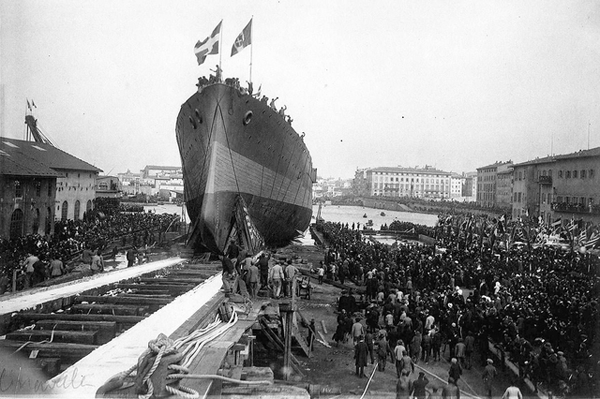
Launch of Giorgios Averof, 12 March 1910 in Livorno.
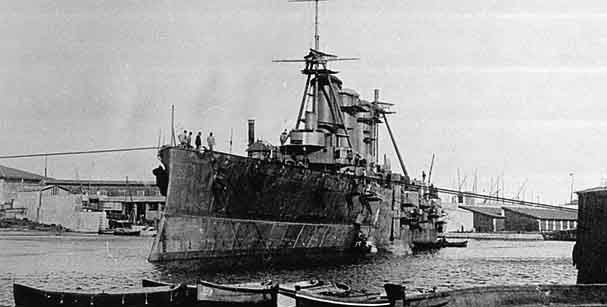
Fitting out at Livorno, 1910
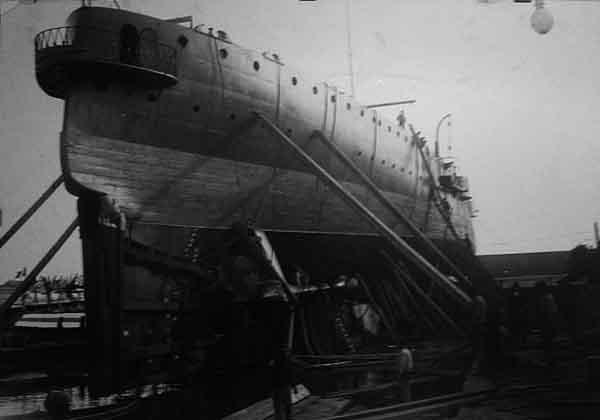
Averof in construction, stern view
Propulsion & performances
Propulsion-wise, These cruisers had two vertical triple-expansion (VTE) steam engines, connected each to a propeller shaft. Steam was provided by 22 French Belleville coal-burning boilers. Maximum output as designed was 20,000 indicated horsepower (15,000 kW), speed contracted was 22.5 knots (41.7 km/h; 25.9 mph). However on trials, both easily bested this, reaching 23.47–23.6 knots (43.47–43.71 km/h; 27.01–27.16 mph), on a 20,260–20,808 ihp output. Their cruising range was 2,500 nautical miles (4,600 km; 2,900 mi) at 12 knots (22 km/h; 14 mph), but still 1,400 nautical miles in emergency at 21 knots (39 km/h; 24 mph). For the closest shores of the Mediterranean, this was good. The Averof was a singular ship, a product of the already international shipping industry and network supply of the time: She had Italian VTE engines, French boilers, but also British guns and German electric generators.
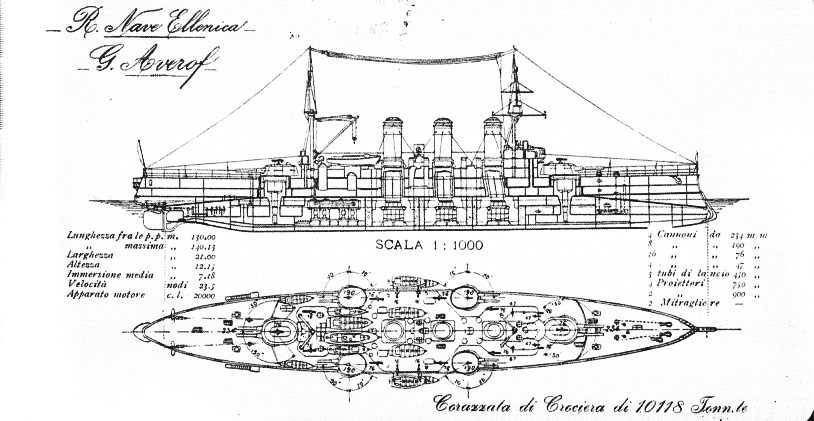
Blueprint of the Averof – Orlando Yard.
Armament
The standard of the day was already the “semi-dreadnought” concept. The Regina Elena were based on Cuniberti’s ideas, and so were the Pisa-class. They combined indeed a powerful main armament, classic for armoured cruisers, with four 254 mm and eight 190 mm, the latter bringing quicker fire. The only problem in that configuration revealed in action later, was the water plumes of both seemed to be too similar for accurate spotting. It should have been compensated by the lower caliber of the secondaries (not 8-in but 7.5 in) but the main rounds were in reality 9.2 in shells. Nevertheless, the Pisa-class, the last Italian armoured cruisers, gave Greece the opportunity of acquiring a state-of-the-art vessel that will certainly bring the Hellenic naval force to a new level, especially compared to the Ottoman fleet.
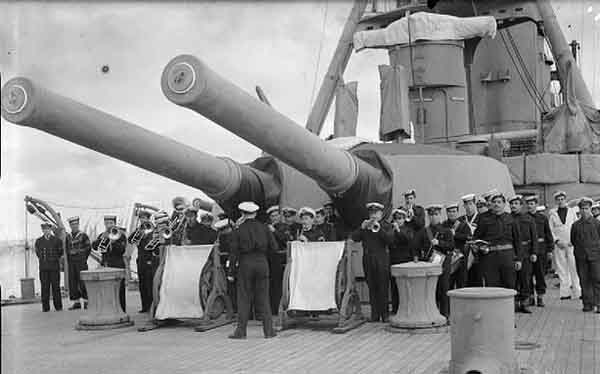
Forward main gun turret
Main armament: The Pisa-class comprised two turrets with two Cannone da 254/45 V Modello 1906 each. They were hydraulically powered, posted forward and aft, 254 mm (10.0 in) un caliber. They fired a 217–224-kilogram (478–494 lb) AP shell at 869 mps (2,850 ft/s). However in practice, smaller 234 mm (9.2 in) purchased from Britain were used. This 380-pd (170 kg) shell, Elswick Pattern had a lower muzzle velocity of 2,770 feet fps. It should be noted that she diverged also from Italian ships by having differently shaped turrets: These were rounded pillbox-form housings, with convex roof plates, not vertical. Also she differed from the Pisa by having a foremast.
Secondary: Eight Cannone da 190/45 V Modello 1906, in also hydraulically powered four twin turrets on the side amidships. These Vickers 190 mm (7.5 in) guns fired a 91 kg (201 lb) AP shell at 850–870 m/s but fired also the Pattern ‘B’ 90.7-kilogram (200 lb) AP shells (844 m/s).
Tertiary: Light armament was double, first 16 Vickers QF Cannone da 76/50 V Modello 1908. They fired a 6.5-kilogram (14 lb) shell at 930 mps (3,100 ft/s). Also they carried four QF Cannone da 47/40 V Modello 1908, whereas the original Pisa class had eight. Also the Pisa had three submerged 450 mm (17.7 in) torpedo tubes whereas Georgios Averof had larger 457 mm (18.0 in) tubes.
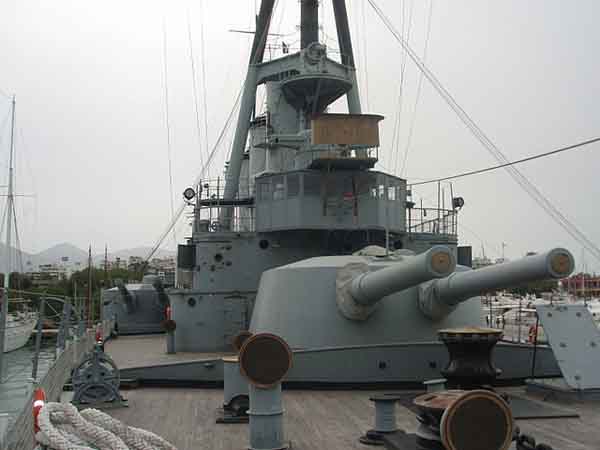
Forward main gun turret – as of today.
Armour protection
The Pisa, Amalfi and Averof shared the same armor design, without change. They were protected by an armored belt, 200 mm (7.9 in) thick amidships, and down to 90 mm (3.5 in) on both ends of the hull. The armored deck was 51 mm (2.0 in) thick (40 mm for other sources), plunging fire was not really a concern by then. The conning tower had 180 mm (7.1 in) thick walls. The main gun turret faces were 160 mm (6.3 in) thick, while the secondary turrets had 140 mm (5.5 in) faces. The main gun barbettes were up to 180 mm (7.1 in) in thickness.
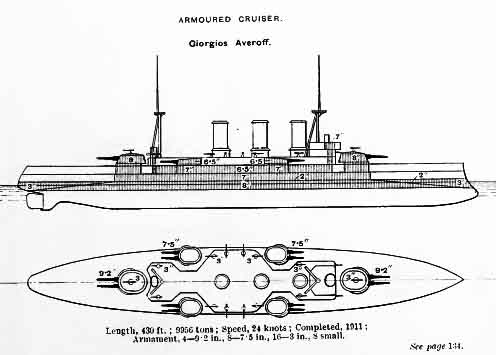
Brassey’s drawing of the Averof
Modernization
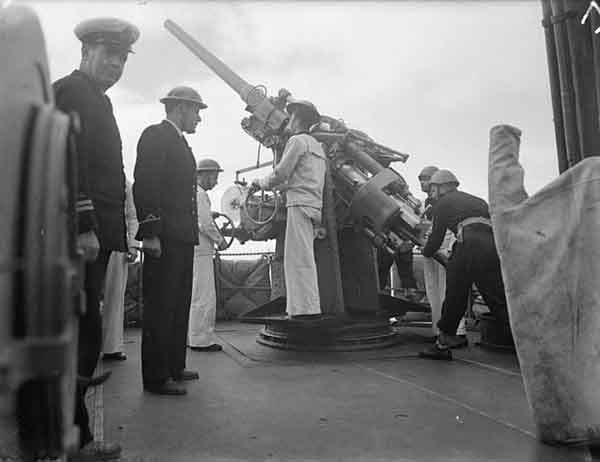
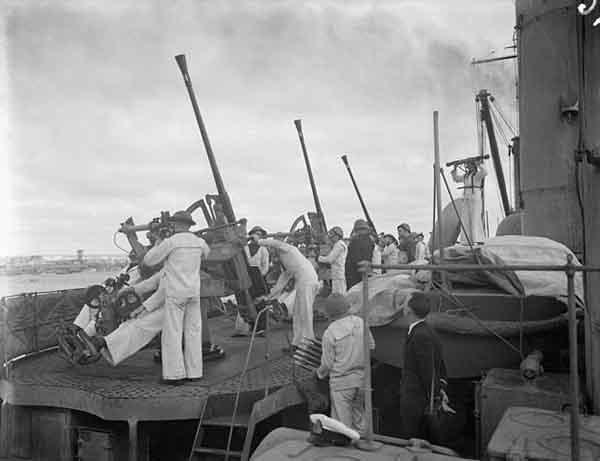
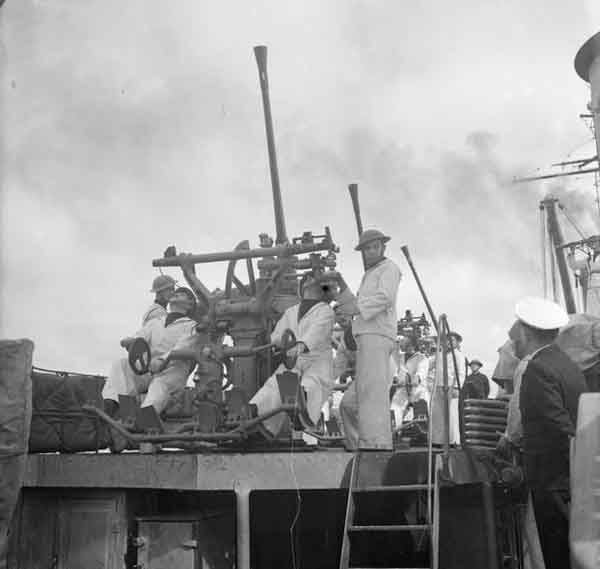
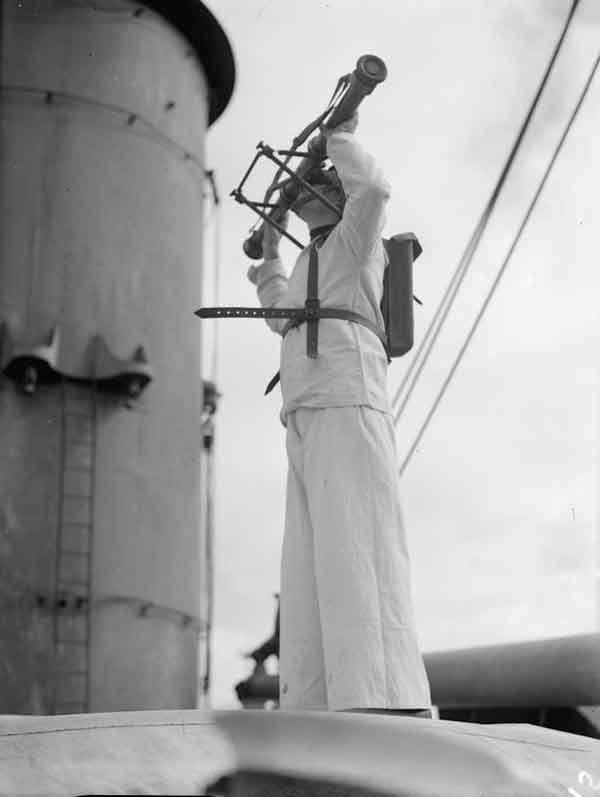
Modern AA on board the Averof, Port said, 1943.
Georgios Averof received a single 76 mm AA gun during WW1 and after her 1925 refit, four antiship QF 76 mm and two 76 mm AA guns, four antiship QF 47 mm, and five 40 mm AA guns. In 1925-1927, she underwent a major refit in France. The most visible improvement was a modern anti-aircraft armament. But a new tripod-foremast was also constructed and a more modern conning tower as well, to support also an improved fire-control equipment.
At the same time, the decks were open to extract the old powerplant, to proceed to a complete replacement of her VTE engines, boilers, and furnaces. However she still burnt coal, but had now fuel-oil spraying mechanism and oil tanks, so its was mixed firing system. The coast of converting her to oil-burning boilers was judged too much. The Averof’s 17-inch torpedo tubes were of course also removed.
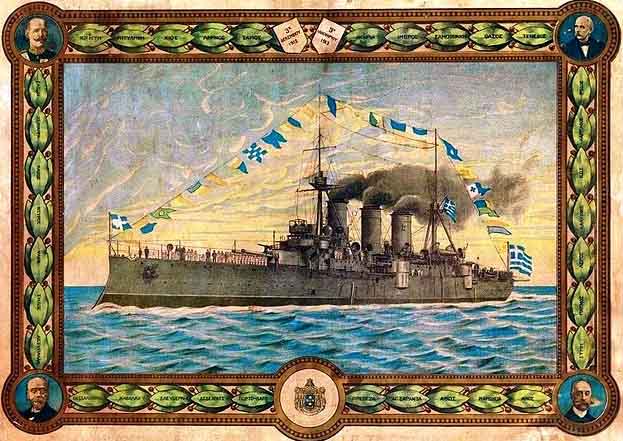
Lithograph by Christidis
RHN Giorgios Averof in service
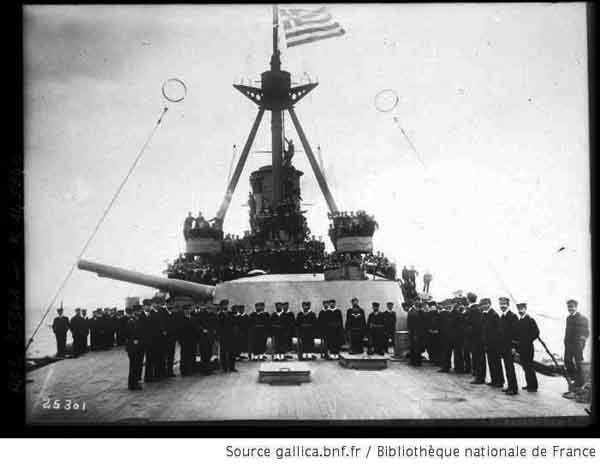
Averof and crew – credits: gallica BNF
The Greeks urged the delivery of the ships so much that they accepted her even having a condemned 190 mm gun: There was a gouge inside the barrel caused by the slip of a rifling tool. Armstrong Whitworth’s chief ordnance engineer however judged it benign. The gun was later “cleaned up” for firing exercises. In May 1911, she was the last commissioned armoured cruiser anywhere in the world. She would be also the last commissioned. Battlecruisers had now the attention of all navies that can afford them.
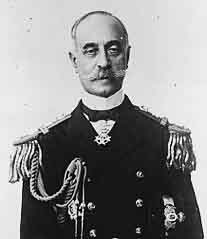 Her first commissioned captain was Ioannis Damianos, and he immediately sailed for the Coronation Naval Review of King George V, which saw one of the largest naval parade ever seen, perhaps the greater gathering of warships before D-Day. There, she also took delivery of her British ammunition. However she ran aground at Spithead on 19 June, and had to be repaired in drydock before returning home. The crew was involved in a large brawl with locals and Captain Damianos was lampooned for being incapable to maintain discipline.
Her first commissioned captain was Ioannis Damianos, and he immediately sailed for the Coronation Naval Review of King George V, which saw one of the largest naval parade ever seen, perhaps the greater gathering of warships before D-Day. There, she also took delivery of her British ammunition. However she ran aground at Spithead on 19 June, and had to be repaired in drydock before returning home. The crew was involved in a large brawl with locals and Captain Damianos was lampooned for being incapable to maintain discipline.
He was replaced by Pavlos Kountouriotis (the taskmaster). Captain Kountouriotis trained the crew and restored discipline but restrained from gunnery practice, ammunition being reserved for more precious occasions. The armoured cruiser reached Faliro Bay near Athens, on the first of September 1911. She became a single most amazing naval asset of the Balkan League, to the Ottoman Empire. Soon she would have the occasion to prove her metal.
The Balkan war
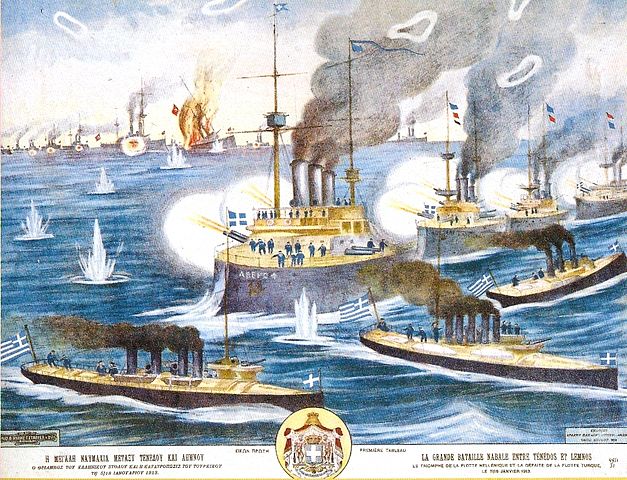
The battle of Tenedos and Lemnos, 1913.
The First Balkan War erupted in October 1912, two years after the brand new armoured cruiser was delivered. Kountouriotis was now a rear admiral, commander-in-chief of the Hellenic Royal Navy, with his mark on the Averof, now under Captain Sofoklis Dousmanis. She started a very long career as a flagship. She first sail to escort troopships for seizing islands of the northern and eastern Aegean. Of course she was present at the naval battle at Elli, on 3 December 1912 and of Lemnos on 5 January 1913. She almost single-handedly secured victory against the Ottoman fleet, and earned for the Balkan league, the mastery of the whole Aegean Sea.
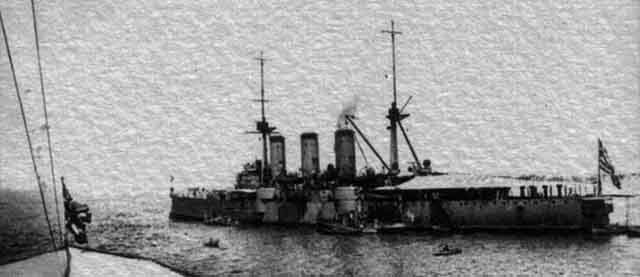
Giorgios Averof put to good use her speed and armament to chase the tail of the Turkish Fleet, at Elli, Kountouriotis just left behind the older Hydra-class ironclads, and hoisted the Flag Signal “Z” for “Independent Action”. At 20 knots (37 km/h) he was able to close in with the Turkish fleet, an crossed their T, concentrating her broadside against the flagship. At Lemnos, this was repeated, for the same result. The rest of the Hellenic fleet was merely a spectator of events unfolding.
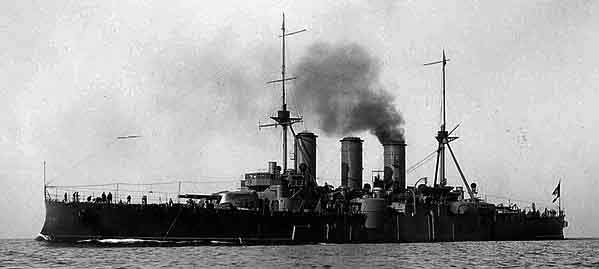
Giorgios Averof in dark grey paint, 1913. Her livery would change at least four times during her long career.
In each battle the ship suffered only slight damage, while inflicting severe damage to several Turkish ships. These exploits propelled her and her Admiral to legendary status in Greece. After the Battle of Lemnos, the crew of Averof affectionately nicknamed her “Lucky Uncle George”. It is a notable fact that, due to the aforementioned need to conserve ammunition which had to be secured from Britain, Averof fired her guns for the first time during the Battle of Elli.
After these two supremacy battles, Georgios Averof closing the Aegean Sea to any Ottoman reinforcements to the front. The First Balkan War was largely won thanks to the ship alone. Because of this, the stranded Ottoman forces lacked supplies and men, and would suffer decisive defeats leading to the end of the war. It’s a rare occurrence in naval history when a single ship could change historical events in a grand scale, due to the repercussions for the Ottoman Empire and the whole middle east and southeastern Europe as a whole.
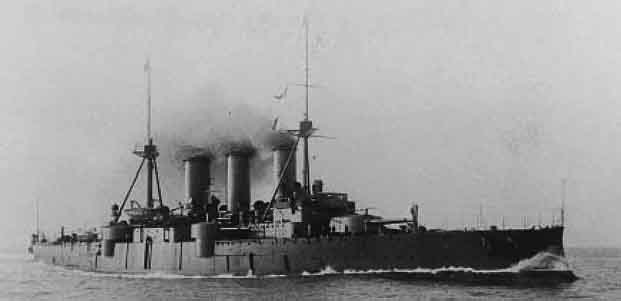
Giorgios Averof underway, circa 1914
The great war
In August 1914, Greece will was to stay outside the conflict, and the flagship saw little service. In addition there was internal turmoil, and the Noemvriana riots of 1916 caused a French force to seize the ship returned to Greece as a condition for Greece entering war on the side of the entente in June 1917. At that time, the Ottoman navy was committed in the black sea due to the entente blockade of the Dardanelles, so a duel between the Averof and Yavuz was unlikely to ever happen. More so, in between, the purchase of two American pre-dreadnoughts, the Kilkis and Lemnos, did not change the position of Averof as flagship. They were indeed slower, and simply replaced the old hydra class.
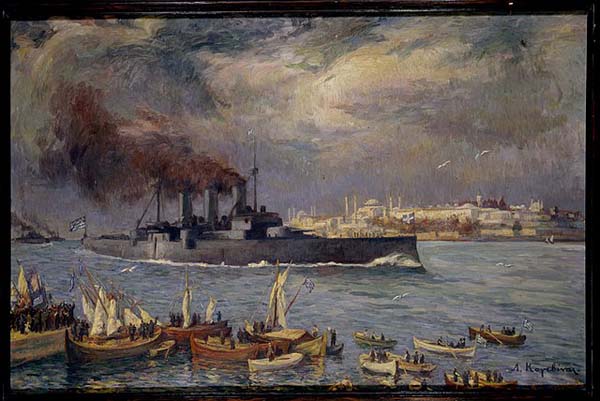
1919, Bosphorus

Coast of Crete 1919
Led by Averof in 1918, the Hellenic fleet with other entente vessels rallied Constantinople at the armistice, feasted by Greeks locals. Admiral Ioannis Ipitis took command of the fleet, with his mark on the cruiser as flagship throughout 1919. The Greek-Turkish War saw the armoured cruiser covering troop landings in Eastern Thrace. She also passed the Dardanelles and rampaged the Black Sea pontic coast. However the young turks army soon retook initiative and Greek troops were chased of. Averof took refugees on board before retuning to Greece.
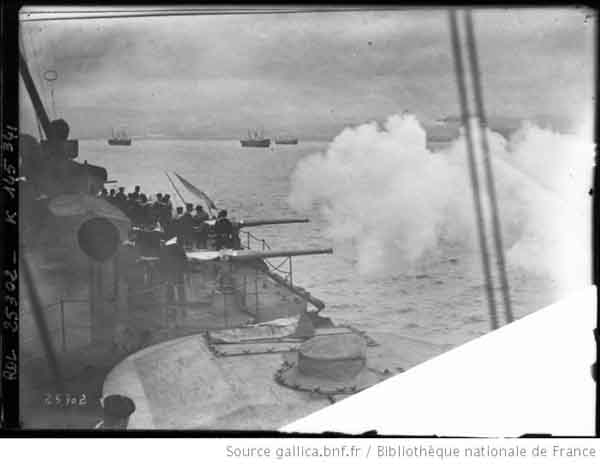
Averof firing at sea
The interwar
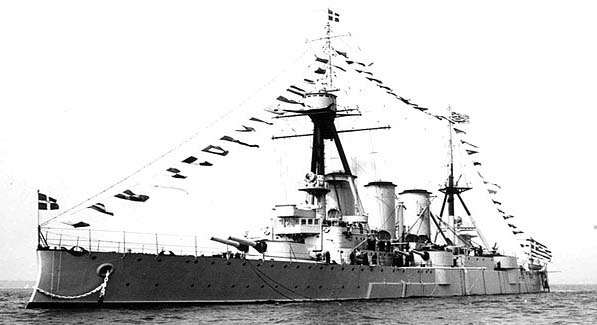
Giogios Averof at the 1937 Spithead review
The years 1922-25 records are scarce. No major events for the cruiser was to be noticed. Starved of budget, the ship stayed mostly inactive. However in 1925 it was obvious the cruiser was no longer relevant and funds were unlocked for a refit; This work was done in France in 1925-1927. Outside AA, this concerned the fire direction and powerplant. Back to Greece she stayed as flagship, doing little exercises. On 20 May 1937, she joined fourteen other fleets, 150 vessels, for the Spithead Coronation Naval Review.
And from these 150 vessels she was the only one that has been present to the Coronation review of 1911. A peculiarity underlined by King George VI, aware of this, greeting particularly Averof’s captain, with a status of special naval guests. The years 1937-39 were calm, the Hellenic fleet has been reinforced by a few submersibles and destroyers, just enough to stay on par with the Turkish Navy.
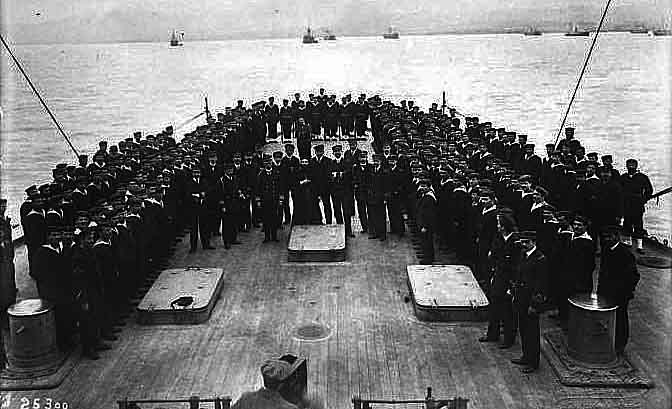
Kontouriotis and his crew on the deck
World war two
The war broke out with Greece staying neutral. After the Italian invasion, the fight focused on land, so the fleet took little part in it. In April 1941, the German army intervened to secure the Balkans and after Yugoslavia, they invaded Greece. The Greek Army front began to collapse and on 18 April 1941, the Averof’s crew received the order to scuttle their ship to prevent capture. They did what French officers refused to do: They disobeyed orders, cut through the closed harbor-boom with axes and ropes to the pier. The commanding officer was of on board and later joined with a other ship, being transferred on a rope ladder while underway.
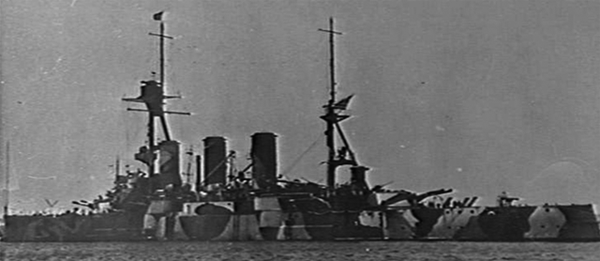
Giorgios Averoff in camouflage, Bombay 1942
The rest of the fleet has been mercilessly hammered by the Luftwaffe, the destroyer Helle has been sunk in august 1940 already, both battleships of the Kilkis class in the Piraeus, all torpedo boats, the destroyers Leon, Psara, Hydra, the submersibles Proteus, were all sank by the Luftwaffe. So the Giorgos Averof escape was a miracle. She was to redeem the Hellenic Navy with the survivors, destroyers Kondouriotis and Spetsai, Vasilefs Giorgios and Vasilissa Olga, five submarines and various lighter crafts. They will join the allies, in Crete and then Alexandria.
On her part, Giorgios Averof rallied Souda Bay, in Crete and the headed for Alexandria, arriving on 23 April 1941. The Hellenic fleet was integrated into the Royal Navy eastern Mediterranean command. Due to her age, the RN staff did not known what to do with her. She had a slow speed, limited range (and burnt coal), plus had obsolete artillery and insufficient AA. The only job she was given was ordered to escort Indian Ocean convoys.

A colorized photo of the ship
She still had quite a considerable firepower and the armour protection of a battleship, so she was perfectly able to deal with 150 mm armed German raiders that targeted these convoys. The convoy generally sailed to 12 knots so she was faster, able to circle around the convoy and shift positions en route if needed. She started this task in September 1941 with British liaison officers on board for command and control. In between escorts with Alexandria, she was posted to Bombay, making patrols in the Indian Ocean, camouflaged (see photos).
Back to Alexandria after another convoy of Indian troops, she left Alexandria on 30 June and rallied Port Tewfiq (Port Suez). The crew rescued sailors and soldiers carried by the Cunarder troopship MV Georgic sank by the Luftwaffe on 6 July. However by that time, her powerplant felt her age. With the lack of maintenance, problems accumulated. Several of her boilers were deactivated, and her fuel-oil spraying mechanisms were unusable. Averof could only sail to 9 knots.

Side of the ship in 1943
The fleet command decided as she was no longer capable of convoy duties from 20 July, to be based at Port Sudan. There she was drydocked and for three weeks teams tried to fix her boilers issues. They fitted an oil-accelerant apparatus notably, which allowed the cruiser to reach a better cruising speed. She crossed the Red Sea to Aden by late August and sailed with another convoy in the Indian Ocean bound to Bombay, where she arrived on 10 September 1941.
However powerplant issues continued to plague the cruiser. Ultimately her convoys duties were cut short. On 28 September however she escorted the oil tanker convoy BP.16 Bombay-Basra in the Persian Gulf. She left the convoy en route, due to faulty boilers. This could not fell at the worst moment, as from 24 September, the German auxiliary cruiser KMS Kormoran just spotted and sank the freighter Stamatios G. Embiricos (en route to Columbo, Ceylon, which signalled the raider) and was ready to fell on the convoy within a week. But instead, the Kormoran moved southeast, heading for Australia where she mate her fate with HMAS Sydney. Convoy BP.16 reached Basra on 5 October while Giorgos Averof was back to Bombay on 4 October. Repairs and maintenance lasted until 20 December, when she finally left, escorting the troop convoy BM.31B bound for Singapore. She was back to Bombay on 5 January 1942.
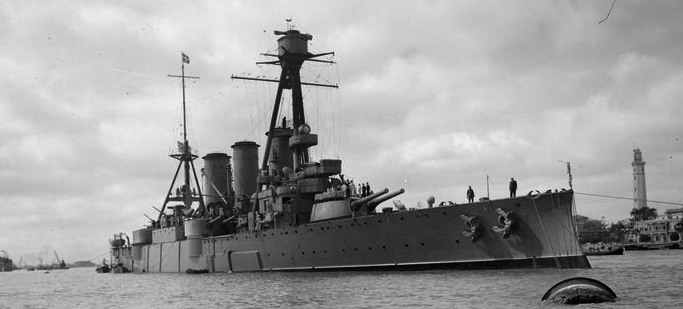
Giorgios Averof after her camouflage was retired, circa 1943 (IMW)
On 9 January 1842, HRN Averof departed to meet six troopships sailing from Bombay and Karachi, bound for Basra. As she travelled at 14-16 knots, she failed the meeting and instead it was decided to convert her as a patrol vessel, distant cover for the sea lane. In the Gulf of Oman, she spotted an alleged German raider, but this proved a false alert.
The captain following this alert called to gunnery practice when back to Bombay on 15 January 1942. When firing her 8-in guns, vibrations and recoil were enough to dislocated the basis of active boilers, which rolled on deck, causing considerable damage. She was repaired again in Bombay, departing in early November 1942, and called by derision “Georgios Never-off”, at the base by British personnel. Stuck at 12 knots, she joined Port Said before transiting through the Arabian and Red Seas, and be used as a Suez Canal guard ship by November 1942.
Supply was not a problem for the old ship. British 9.2-inch ordnance was stockpiled to be used by fortifications and can be supplied. Same story for the 7.5-inch naval guns, still in service with the Hawkins-class heavy cruisers and fortifications. Production was even maintained. But the cruiser had a very troublesome and totally spent powerplant and only the role of a guard ship sited her. She served at Port Said in Egypt for the remainder of 1942, 1943 and until late 1944.
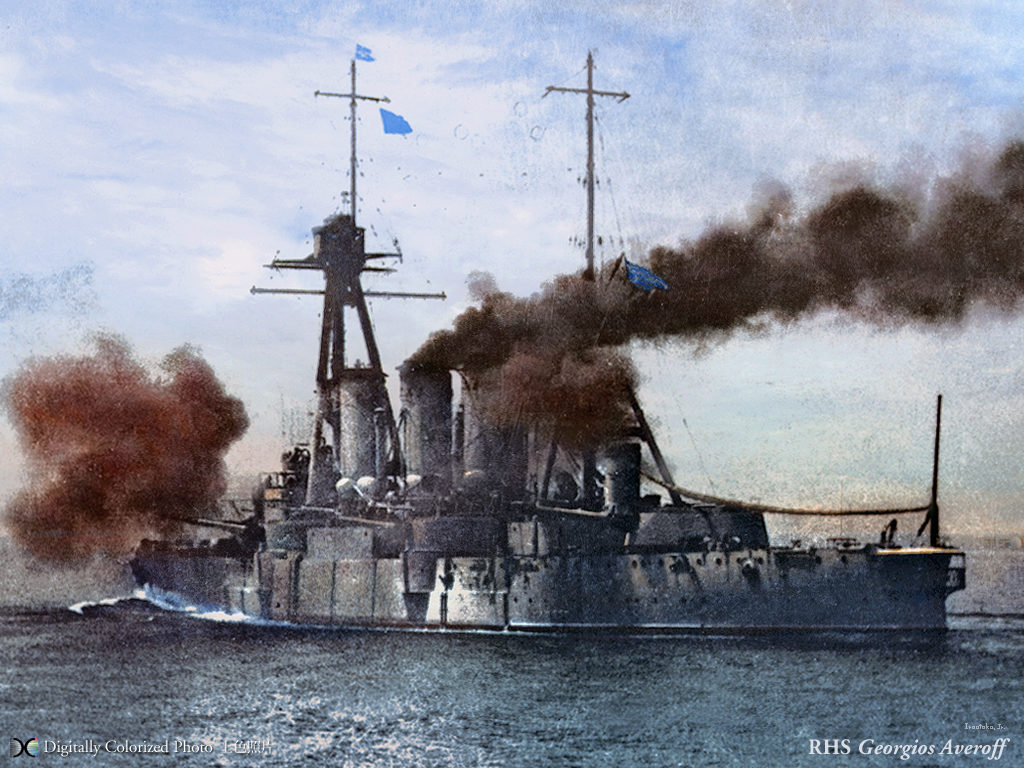
A colorized photo of the ship firing
On 17 October 1944, Captain Theodoros Koundouriotis, the Admiral’s son, took command, and the cruiser departed with the Greek government-in-exile from Cairo to liberated Athens. Sge served as a Fleet Headquarters and was decommissioned in 1945 for some sources (like Conway) or the more accepted date of 1952. She was anchored at Salamis, waiting for her fate.

The cold war years and preservation
Eventually the old veteran was not sold for BU. She sailed to Poros, where she was berthed from 1956, until 1983 to serve as a training vessel. After 1984, she was now too precious to met the ship-breakers torch, and the government esteemed she was a national treasture, worth paying a restoration and conversion as a museum ship. She was towed again, this time to Palaio Faliro, starting her service as a museum ship, and promoting the traditions of the Greek navy. In 2016, she had so many visitors that it was decided to fir a an internal elevator for easier access to all decks, notably to comply with European regulation about museums for disabled persons and the elderly. Berthed at Trocadero quay in Naval Tradition Park she went on her new public service.
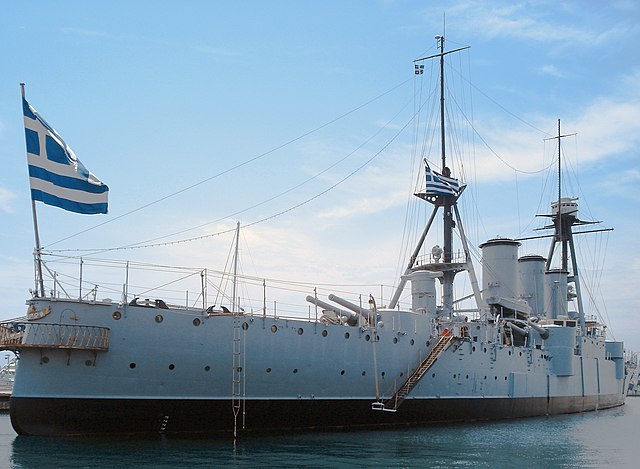

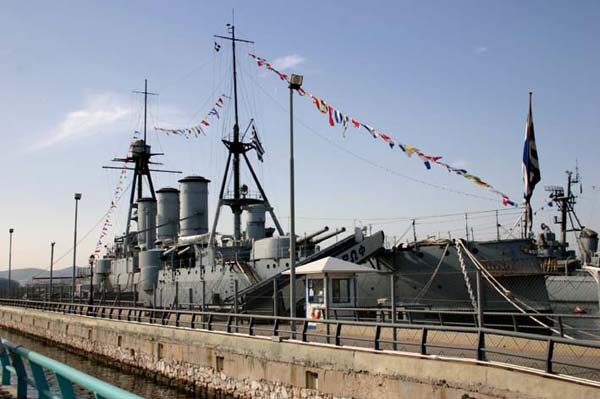
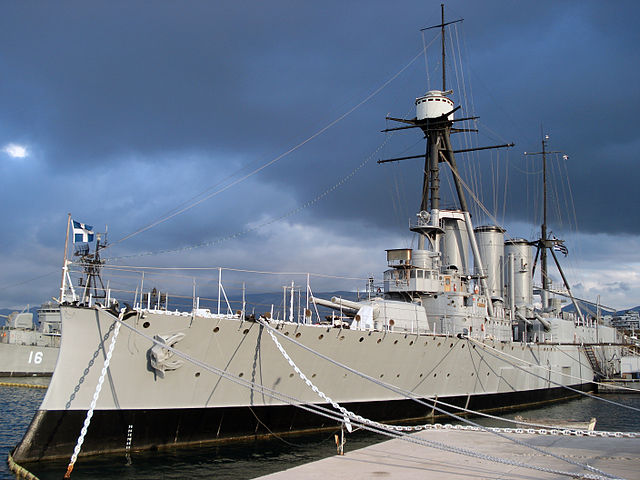
Various views of the cruiser in the last 20 years
What is particular is she is still under the responsibility of the Navy. Her maintenance and public host crew is under the nay payroll and obsligation, while the ships bears the Rear Admiral’s square blue flag with white cross rank flag mounted on the flagstaff side atop the mainmast. Every Ship that passed through or existing Faliro Bay salutes the Averof by any means available, mostly horns. When this happens, navy personal stands to attention while officers salutes. A scandal erupted whe journalists reported in 2016 a lavish party on board by a billionaire that rented the ship.
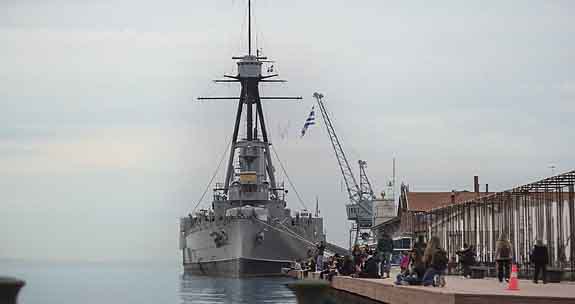
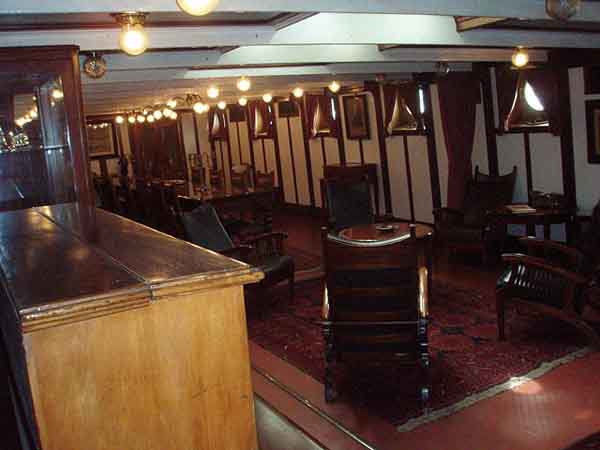
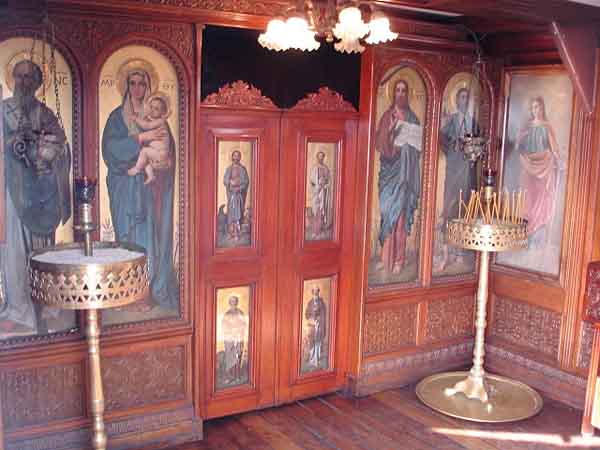
Bow, mess and chapel on board
On 26 April 2017, she was towed to Skaramangas Shipyard (Elefsis) under responsibility of Commodore Sotirios Charalampopoulos, for two months of drydock maintenance and repairs. Going on a tradition of partial private funding (since 1906!) , the work was paid by magnate and philanthropist Alexandros Goulandris. By May 2017, hismelf and a small team was proceed to a compehensive survey of the ship to replace parts needed for her to sail again and cruiser the Aegean under her own power. But Goulandris died on 25 May 2017 and the project was dropped and still is today in 2020. If it’s carried out one day (economic crisis and COVID apart, not immediately) the Averof, still crewed by the Navy would be the world’s oldest almost continuously operational vessel to sail.
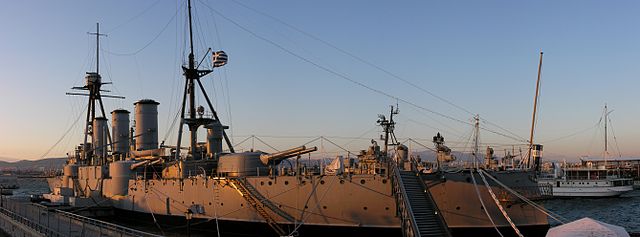
Read More
http://averof.mil.gr/
//en.wikipedia.org/wiki/Greek_cruiser_Georgios_Averof
//www.hnsa.org/hnsa-ships/bs-georgios-averof/
//www.navypedia.org/ships/greece/gr_cr_averof.htm
//www.hellenicnavy.gr/en/news/latest-news/item/8163-maintenance-of-the-historical-battle-cruiser-georgios-averof.html
//www.ww2wrecks.com/portfolio/velos-and-georgios-averoff-the-floating-museums-of-greece/
//uboat.net/allies/warships/ship/9898.html

Rendition profile of the Averof in 1914 by the author
The models corner
//www.steelnavy.com/AveroffTour.htm

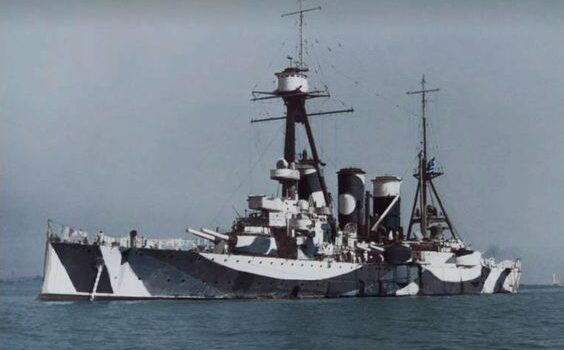

 Latest Facebook Entry -
Latest Facebook Entry -  X(Tweeter) Naval Encyclopedia's deck archive
X(Tweeter) Naval Encyclopedia's deck archive Instagram (@navalencyc)
Instagram (@navalencyc)





 French Navy
French Navy Royal Navy
Royal Navy Russian Navy
Russian Navy Armada Espanola
Armada Espanola Austrian Navy
Austrian Navy K.u.K. Kriegsmarine
K.u.K. Kriegsmarine Dansk Marine
Dansk Marine Nautiko Hellenon
Nautiko Hellenon Koninklije Marine 1870
Koninklije Marine 1870 Marinha do Brasil
Marinha do Brasil Osmanlı Donanması
Osmanlı Donanması Marina Do Peru
Marina Do Peru Marinha do Portugal
Marinha do Portugal Regia Marina 1870
Regia Marina 1870 Nihhon Kaigun 1870
Nihhon Kaigun 1870 Preußische Marine 1870
Preußische Marine 1870 Russkiy Flot 1870
Russkiy Flot 1870 Svenska marinen
Svenska marinen Søværnet
Søværnet Union Navy
Union Navy Confederate Navy
Confederate Navy Armada de Argentina
Armada de Argentina Imperial Chinese Navy
Imperial Chinese Navy Marinha do Portugal
Marinha do Portugal Mexico
Mexico Kaiserliche Marine
Kaiserliche Marine 1898 US Navy
1898 US Navy Sovietskiy Flot
Sovietskiy Flot Royal Canadian Navy
Royal Canadian Navy Royal Australian Navy
Royal Australian Navy RNZN Fleet
RNZN Fleet Chinese Navy 1937
Chinese Navy 1937 Kriegsmarine
Kriegsmarine Chilean Navy
Chilean Navy Danish Navy
Danish Navy Finnish Navy
Finnish Navy Hellenic Navy
Hellenic Navy Polish Navy
Polish Navy Romanian Navy
Romanian Navy Turkish Navy
Turkish Navy Royal Yugoslav Navy
Royal Yugoslav Navy Royal Thai Navy
Royal Thai Navy Minor Navies
Minor Navies Albania
Albania Austria
Austria Belgium
Belgium Columbia
Columbia Costa Rica
Costa Rica Cuba
Cuba Czechoslovakia
Czechoslovakia Dominican Republic
Dominican Republic Haiti
Haiti Hungary
Hungary Honduras
Honduras Estonia
Estonia Iceland
Iceland Eire
Eire Equador
Equador Iran
Iran Iraq
Iraq Latvia
Latvia Liberia
Liberia Lithuania
Lithuania Mandchukuo
Mandchukuo Morocco
Morocco Nicaragua
Nicaragua Persia
Persia San Salvador
San Salvador Sarawak
Sarawak Uruguay
Uruguay Venezuela
Venezuela Zanzibar
Zanzibar Warsaw Pact Navies
Warsaw Pact Navies Bulgaria
Bulgaria Hungary
Hungary

 Bundesmarine
Bundesmarine Dutch Navy
Dutch Navy Hellenic Navy
Hellenic Navy Marina Militare
Marina Militare Yugoslav Navy
Yugoslav Navy Chinese Navy
Chinese Navy Indian Navy
Indian Navy Indonesian Navy
Indonesian Navy JMSDF
JMSDF North Korean Navy
North Korean Navy Pakistani Navy
Pakistani Navy Philippines Navy
Philippines Navy ROKN
ROKN Rep. of Singapore Navy
Rep. of Singapore Navy Taiwanese Navy
Taiwanese Navy IDF Navy
IDF Navy Saudi Navy
Saudi Navy Royal New Zealand Navy
Royal New Zealand Navy Egyptian Navy
Egyptian Navy South African Navy
South African Navy






























 Ukrainian Navy
Ukrainian Navy dbodesign
dbodesign
”modified Italian Pisa-class armored carrier,”
I’m pretty sure it was a cruiser
Amazing typo !
Thanks for spotting it. Fixed.
Hi, I have an issue in my Android cell phone. There’s a black band covering the text left side, not present in the web PC version. Thank you
Hello Jorge, apparently it’s the search button that goes berserk. I saw it and i’m on it. It’s there each time the screen is reduced since a recent WP upgrade. Thx !